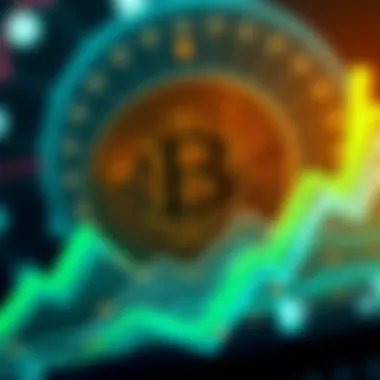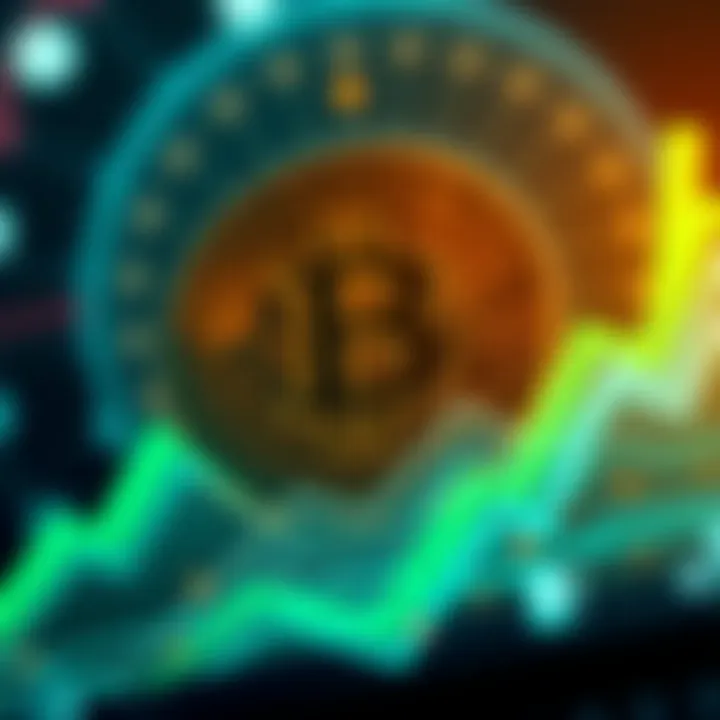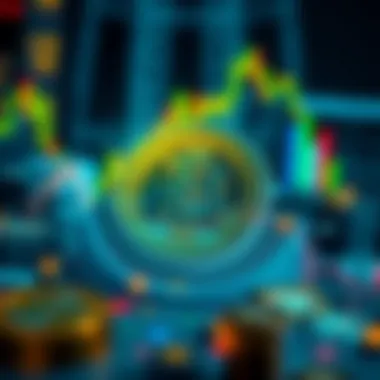Explore Decentralized Finance ETFs and Their Impact


Intro
In the ever-evolving world of finance, Decentralized Finance (DeFi) has emerged as a game changer, reshaping traditional notions of banking and investment. Among the myriad innovations stemming from this arena are Decentralized Finance Exchange-Traded Funds (ETFs), which have garnered a fair share of attention and curiosity. These ETFs offer a unique blend of cryptocurrency exposure and traditional investment strategies, attracting both seasoned investors and those new to the crypto landscape.
As the popularity of DeFi grows, understanding its intricacies becomes essential for anyone looking to navigate this complex field. This article delves into what makes DeFi ETFs tick, their relevance in today's market, and the myriad strategies that investors can employ. We shall also address the challenges these financial instruments face, especially regarding regulation and market fluctuations. By the end of this piece, readers will be better equipped to grasp the potential of DeFi ETFs and how they fit into the broader investment landscape.
Market Trends
Current Market Analysis
The market for DeFi ETFs can be viewed through a dynamic lens, reflecting both the rapid adoption of cryptocurrency and the fluctuating interest in decentralized finance. As of this writing, the total market capitalization of cryptocurrencies sits comfortably above a trillion dollars. Within this vast ecosystem, DeFi ETFs represent a fraction, but one that is rapidly growing. Investors are increasingly keen on finding ways to capitalize on the rising tides of decentralized finance without directly engaging in the volatility of individual cryptocurrencies.
Several prominent ETFs have recently risen to prominence, tracking a range of DeFi projects and tokens. Notable ones include the Bitwise DeFi Crypto Index Fund and the Invesco Alerian Galaxy Crypto Economy ETF. These funds typically include tokens from various DeFi projects, offering investors diversification alongside exposure to this burgeoning market.
Historical Trends and Patterns
To comprehend the present landscape, it's crucial to draw comparisons with historical trends. The DeFi sector began gaining traction in 2017, and despite some bumps along the way, including regulatory uncertainties and market corrections, it has charted a path of innovation and growth. The rise of yield farming and liquidity mining have significantly influenced market behaviors and investor sentiments.
In past years, the influx of liquidity into DeFi protocols created a compelling narrative, driving historical price increases in various tokens associated with these funds. For instance, indicators show a marked growth in the total value locked (TVL) across DeFi platforms, which peaked during the bull markets of late 2020 and 2021. Looking back, these patterns suggest that investor sentiment often correlates with wider trends in the cryptocurrency space, making it imperative for potential investors to stay informed and vigilant.
Investment Strategies
Long-Term vs Short-Term Investments
Investors have a variety of strategies at their disposal when it comes to engaging with DeFi ETFs. One can either take a long-term perspective, aiming to benefit from the gradual adoption of decentralized finance, or opt for short-term trading, capitalizing on market volatility.
- Long-Term Investments: This strategy hinges upon the belief in the sustained growth of the DeFi ecosystem. Long-term investors often look for established projects and solid fundamentals, preferring ETFs that follow a diversified index of tokens fundamentally tied to the DeFi space.
- Short-Term Investments: On the flip side, some traders might lean toward actively trading ETFs, seeking to profit from daily or weekly price swings. Success in this domain requires a keen understanding of market trends, technical analysis, and timing.
Risk Management Techniques
Regardless of the chosen strategy, risk management stands as a crucial component of investing in DeFi ETFs. Investors should consider implementing measures such as:
- Diversification: Spreading investments across different DeFi ETFs and tokens can help mitigate risk associated with individual assets.
- Stop-Loss Orders: Setting stop-loss orders can shield investments from drastic downturns, ensuring that funds are allocated responsibly.
- Regular Portfolio Review: Periodically assessing the performance of investments enables investors to make informed decisions regarding adjustments to their strategy.
"Understanding the risks and dynamics of DeFi is not just beneficial, it's essential for smart investing today."
As the landscape evolves, staying alert to changes and trends becomes paramount. Resources like CoinMarketCap and DeFi Pulse can serve as critical tools for investors aiming to keep their finger on the pulse of DeFi trends and metrics.
By juxtaposing historical data with current trends, future investors can navigate the complexities and take calculated risks when investing in Decentralized Finance ETFs.
Prologue to Decentralized Finance
The financial landscape is evolving at a pace that many find hard to keep up with. One of the most significant shifts has come from the rise of Decentralized Finance, commonly known as DeFi. This movement is gaining traction as an alternative to traditional financial systems, aiming to provide a more democratized approach to finance. The importance of diving into the world of DeFi goes beyond mere curiosity; it addresses fundamental questions about how we manage, invest, and transact with our assets.
Definition of Decentralized Finance
At its core, decentralized finance aims to recreate and improve upon traditional financial systems using blockchain technology. It eliminates the need for central intermediaries like banks and brokers, allowing individuals to engage directly in financial activities such as lending, borrowing, and trading. In simpler terms, DeFi represents a shift in power from institutions to individuals, opening up access to financial services for those who were previously excluded.
Decentralization means that no single entity has control over the entire system, creating a more transparent and fair environment for users. This concept not only provides users with autonomy but also reduces the risks associated with financial downtime or failures of a central authority.
Evolution of DeFi
The evolution of DeFi has seen several phases, beginning from its inception with the launch of Ethereum in 2015. Initially, Ethereum provided a platform for creating decentralized applications, paving the way for various financial tools and services. Fast forward to 2020, DeFi saw explosive growth, often referred to as the ‘DeFi Summer.’ Thousands of projects emerged, ranging from decentralized exchanges like Uniswap to lending platforms such as Aave.
The growth has been fueled by a combination of factors: low-interest rates in traditional finance, a burgeoning interest in cryptocurrencies, and the desire for financial accessibility. Though still in its early stages, the technology and principles behind DeFi are constantly being refined and expanded, demonstrating a remarkable resilience and adaptability in addressing the needs of users.
The Vision Behind DeFi
The vision of decentralized finance extends beyond merely being an alternative to traditional finance. It seeks a complete financial infrastructure that is open, inclusive, and globally accessible. Imagine a world where anyone with internet access can not only trade cryptocurrencies but also obtain loans, earn interest, or purchase insurance—all without a bank account.
This vision is driven by the principles of transparency, security, and autonomy. DeFi platforms provide users with greater control over their funds, significantly reducing the chances of manipulation and fraud. Additionally, the blockchain technology underpinning DeFi offers unprecedented security measures, ensuring that transactions are inherently traceable while remaining anonymous.
Decentralized Finance ETFs Explained


Decentralized Finance ETFs represent a significant shift in the investment landscape, embracing the philosophies of decentralized finance while providing investors a more structured approach to participate in this innovative sector. The essence of these funds lies in their ability to provide exposure to the diverse and rapidly evolving world of decentralized finance, from lending protocols to yield farming assets. By tapping into this decentralized ecosystem, investors can leverage advanced financial products in a way that traditional finance often fails to accommodate.
What is a DeFi ETF?
A DeFi ETF, or decentralized finance exchange-traded fund, is an investment fund traded on stock exchanges, similar to traditional ETFs. The striking difference is that DeFi ETFs focus primarily on blockchain-based assets that enhance transparency, efficiency, and access through smart contracts. Essentially, these funds are designed to give investors exposure to the burgeoning market of digital assets without the need for direct ownership, offering a more convenient entry point.
Investors in these ETFs aren’t just betting on individual cryptocurrencies; they are getting a slice of various protocols or financial products — everything from stablecoins to decentralized exchanges — that contribute to the highly interconnected world of DeFi. This structure can make it easier for both seasoned and novice investors to allocate capital into new opportunities that may otherwise be daunting to navigate.
Structure of a DeFi ETF
Understanding the structure of a DeFi ETF helps to outline its functional mechanics.
- Asset Composition: Most DeFi ETFs will include a mix of various DeFi assets such as governance tokens from lending platforms, stablecoins, and other cryptocurrencies that facilitate decentralized transactions.
- Management of the Fund: The management of these ETFs can vary, with some adopting a passive strategy that mirrors the performance of selected indices, while others may take an active management approach. An active strategy could involve adjustments based on market conditions, aiming to seize opportunities as they arise.
- Custodianship and Security: Given the nature of blockchain technology, funds managing these ETFs usually involve robust security measures, including multi-signature wallets and regular audits to ensure asset safety.
This structure ensures investors can engage with a range of DeFi protocols while minimizing the complexities associated with purchasing and managing multiple assets directly.
How DeFi ETFs Differ from Traditional ETFs
While there are fundamental similarities between DeFi and traditional ETFs in terms of providing diversified exposure, some stark differences make DeFi ETFs stand out:
- Underlying Assets: Traditional ETFs typically hold equities or bonds. In contrast, DeFi ETFs possess digital assets tied to blockchain technology, enabling unique functionalities like immediate settlement and eliminating the need for a central authority.
- Investment Mechanisms: DeFi ETFs often use smart contracts, providing instantaneous and automated processes for transactions, while traditional ETFs engage in more time-consuming operational frameworks.
- Market Accessibility: DeFi ETFs can be accessed globally through a digital wallet, while traditional ETFs are generally available through brokerage accounts that may have geographic restrictions.
- Cost Structures and Fees: Generally, DeFi ETFs can boast lower fees due to the elimination of middlemen and operational efficiencies associated with blockchain technologies.
In essence, by embracing the principles of decentralization, DeFi ETFs present an agile investment vehicle that not only enhances investors' portfolios but also fosters broader participation in the evolving landscape of finance.
"DeFi ETFs embody the fusion of technology and finance, making high-risk opportunities accessible and manageable for everyday investors."
Through this clear differentiation, the growing interest in DeFi ETFs signals not just a shift in investment tools, but a change in how individuals and institutions might approach finance itself.
Key Components of DeFi ETFs
Understanding the key components of Decentralized Finance (DeFi) Exchange-Traded Funds (ETFs) is crucial for anyone diving into the investment landscape. Just like building a house, these components need to work together seamlessly to create a structure that's not only solid but also functional. The fundamental parts that make up a DeFi ETF include underlying assets, the technology that powers these funds, and the mechanisms that ensure liquidity and facilitate trading. Each of these components offers essential insights into how these financial instruments operate and the advantages they present to investors.
Underlying Assets in DeFi ETFs
Underlying assets in DeFi ETFs are the core building blocks. They typically comprise various cryptocurrencies, digital tokens, and sometimes real-world assets that have been tokenized. Unlike traditional ETFs, which may rely on stocks or bonds, DeFi ETFs utilize a diverse set of digital assets, each with its own performance characteristics and market dynamics.
For instance, a DeFi ETF might include assets such as Ethereum, Uniswap tokens, or other decentralized tokens that represent ownership in projects within the DeFi ecosystem. This diversification can help mitigate risk, as the performance of the fund is not solely tied to the fortunes of one asset. Here are a few things to consider with these assets:
- Volatility: The assets can be quite volatile, which means while there's potential for high returns, there's also a significant risk of loss.
- Innovation: Many underlying assets reflect cutting-edge technology and services in finance, giving investors access to the latest in the industry.
- Market Sentiment: The value of these assets often fluctuates based on overall market sentiment, news, and regulatory developments.
Technology Behind DeFi ETFs
The technology underpinning DeFi ETFs is vast and multifaceted. At its core, blockchain technology ensures transparency and traceability. Every transaction and asset management is recorded on a public ledger, making it easier for investors to verify their holdings. Smart contracts – self-executing contracts with terms written into code – are pivotal in enabling automatic execution of trades and maintaining the integrity of the ETF.
Some pertinent technical elements to note include:
- Decentralized Exchanges (DEXs): These platforms are essential for buying and selling DeFi assets within an ETF context. They remove intermediaries and enhance efficiency, but they also can introduce complexity in trading.
- Wallets and Custodianship: Because DeFi assets are held in digital wallets, understanding the security and management of these wallets is essential for investors. The risk of loss or hacking is heightened if wallets are not securely managed.
- Interoperability: Many DeFi ETFs operate across multiple blockchains. The ability to interact with various platforms can optimize asset performance and reduce friction in trading.
Liquidity and Trading Mechanisms
Liquidity in DeFi ETFs is a double-edged sword. On one hand, high liquidity allows investors to sell or buy assets with minimal price discrepancies. On the other hand, liquidity can also be volatile, particularly with lower-cap DeFi tokens that can experience large sways in value depending on the trading volume.
Trading mechanisms play a vital role in how efficiently these ETFs operate:
- Automated Market Makers (AMMs): These facilitate trading directly between users without the need for an order book, relying on liquidity pools instead. Investors can benefit from reduced slippage when trading.
- Yield Farming and Staking: Many DeFi ETFs employ strategies that allow investors to earn rewards by providing liquidity to platforms, thus enhancing the fund's returns.
- Arbitrage Opportunities: Rapid price discrepancies across different exchanges provide avenues for clever traders to capitalize, but they also add an element of risk.
In essence, the combination of underlying assets, advanced technology, and robust trading mechanisms constitutes the crux of DeFi ETFs. As these elements evolve, so too will the landscape of decentralized finance, potentially transforming traditional investment models for good.
Understanding these components can significantly impact how traders and investors navigate the marketplace, making it imperative to grasp their nuances and implications for long-term investment strategies.
Investment Strategies for DeFi ETFs
Investing in decentralized finance (DeFi) ETFs opens up a realm of opportunities for traders and investors alike. By understanding various investment strategies, one can leverage the advantages while navigating any inherent risks. The strategies employed can greatly influence the outcomes of investments, affecting both returns and overall risk exposure. In this section, we take a closer look at active versus passive management, the importance of risk assessment, and how portfolio diversification can aid in creating a balanced investment approach in the context of DeFi ETFs.
Active vs. Passive Management


When it comes to managing investments in DeFi ETFs, two primary strategies emerge: active and passive management.
Active management involves making strategic decisions aimed at outperforming a benchmark index. This could mean continuously analyzing market conditions and trading opportunities, which is essential in the volatile DeFi space. Managers may frequently buy or sell assets to capture short-term price movements, seeking to maximize returns.
On the other hand, passive management entails holding a diversified mix of assets for the long run, with limited trading. This strategy usually tracks a specific index, minimizing trading costs and focusing on long-term growth rather than attempting to time the market.
Depending on an investor's risk tolerance and market knowledge, each approach has its pros and cons. Some investors lean towards active management for potential high returns, while others prefer the stability offered by passive strategies.
Risk Assessment in DeFi Investments
Understanding risk is paramount when diving into DeFi ETFs. The decentralized nature of DeFi opens the door to significant volatility, which can lead to steep losses if not managed correctly. Broader market conditions, technological issues, and changes in regulations can elevate these risks.
Investors must consider various kinds of risks, including:
- Market risk: Any fluctuations in asset prices can significantly affect one's investment returns.
- Liquidity risk: DeFi assets may sometimes be hard to sell depending on market conditions.
- Smart contract risk: Vulnerabilities in the underlying smart contracts can lead to loss of assets.
Conducting thorough risk assessments becomes critical in deciding how much to allocate to DeFi ETFs and in developing strategies to mitigate potential outcomes. An informed strategy can make a significant difference in safeguarding capital.
Portfolio Diversification with DeFi ETFs
Diversification is a cornerstone of sound investing, and this holds true for DeFi ETFs too. By investing in a variety of DeFi projects and assets, investors can spread out their risk exposure, reducing the impact of any single asset's poor performance.
With the advent of DeFi, diversification has taken on a new dimension. It enables investors to:
- Capture returns from various sectors of the DeFi space—such as lending, trading, and yield farming.
- Offset potential losses in one area with gains in another, creating a more balanced risk profile.
- Adapt to the fast-paced changes in the DeFi market, where certain assets can dramatically outpace others.
Choosing the right mix of assets in a diversified DeFi ETF portfolio could mean the difference between a successful investment and a financial misstep.
"Investing in a well-diversified DeFi ETF can not only help manage risk but also enhance overall returns, especially in a market characterized by rapid shifts and innovations."
For more on decentralized finance, you can visit resources like Wikipedia or read more on related topics via Britannica and discussions on Reddit.
By making informed decisions and adopting tailored strategies, investors can position themselves favorably in the DeFi market.
Advantages of Decentralized Finance ETFs
Decentralized Finance ETFs, often referred to as DeFi ETFs, are revolutionizing the way investors access financial markets. Unlike traditional ETFs, which may be limited by the restrictions of centralized finance, DeFi ETFs leverage the essence of blockchain technology, providing a fresh approach to investment. This section explores the various advantages that these innovative investment vehicles offer, emphasizing their significance in today's landscape.
Accessibility for Retail Investors
One of the standout features of DeFi ETFs is their accessibility. Traditionally, investing in complex financial instruments was reserved for the affluent or institutional investors. However, the advent of DeFi ETFs breaks this mold, enabling average retail investors to participate in the decentralized economy without requiring extensive financial knowledge.
The user-friendly platforms associated with DeFi ETFs often allow investors to buy and sell fractions of assets. As a result, even those with limited capital can dip their toes into the water. Furthermore, these investment options operate on an inclusive framework where anyone with a crypto wallet can access. This democratization of finance allows people from various walks of life to engage in investment practices that were once deemed exclusive.
Lower Fees Compared to Traditional Financial Products
In addition to accessibility, DeFi ETFs typically come with lower expense ratios than their traditional counterparts. Many financial products charge hefty management fees and trading commissions. In contrast, the decentralized nature of DeFi platforms minimizes these costs, which can be substantial over time.
For instance, users may face minimal or even zero fees when trading assets within a DeFi ETF framework. This is made possible by smart contracts, which automate processes and reduce the need for intermediaries. Investors are thus left with more of their returns, enhancing the overall investment experience. The lower fees associated with DeFi ETFs are not just attractive—they can lead to greater long-term gains for diligent investors.
Potential for High Returns
The allure of high returns is a fundamental aspect of any investment strategy, and DeFi ETFs certainly don’t fall short in this area. These ETFs often harness the volatility inherent in cryptocurrency markets, which, while risky, also presents lucrative opportunities. With the rapid growth of decentralized finance, investors have the chance to capitalize on emerging assets and trends that traditional finance may overlook.
Investors are often attracted to DeFi ETFs because of their potential to outperform conventional investment vehicles. In a landscape where returns can skyrocket, those willing to embrace the associated risks may find opportunities for significant gains.
"The potential for high returns in DeFi is akin to catching lightning in a bottle. Those who are well-prepared can reap substantial rewards."
In summary, the advantages of DeFi ETFs—accessibility, cost efficiency, and potential for high returns—are spotlighting their role as a powerful tool for modern investment strategies. They continue to evolve, drawing interest not just from seasoned investors but also from those new to the world of finance. This evolution signals a reshaping of the investment landscape, paving the way for a more inclusive and innovative future.
Challenges and Risks Associated with DeFi ETFs
The landscape of decentralized finance (DeFi) is as exciting as it is precarious. With the rapid evolution of this sector, DeFi ETFs (exchange-traded funds) stand at a crossroads, presenting opportunities but also a multitude of challenges and risks. It's crucial for investors, analysts, and traders engaged with DeFi ETFs to understand these elements in order to navigate the complexities of this financial frontier.
Market Volatility


Market volatility is a core element that shapes the performance of DeFi ETFs. This volatility stems from several factors, such as supply and demand dynamics, investor sentiment, and the inherent risks associated with the underlying cryptocurrencies. Unlike traditional assets, cryptocurrencies are susceptible to rapid price swings, often resulting in significant fluctuations within a short time span.
For instance, a sudden regulatory announcement or a significant hack can send prices tumbling. Conversely, positive developments, like partnerships or technological breakthroughs, can spur an immediate price surge. Therefore, investors must be prepared for these dizzying ups and downs. Being fluid and flexible—a quality that many traders tout as vital—is essential when dealing with this level of unpredictability.
Regulatory Uncertainties
Regulatory uncertainties present another daunting challenge for DeFi ETFs. Governments around the world continue to grapple with how to regulate digital assets. In some cases, existing regulations may be out of sync with the innovative nature of DeFi. This misalignment can lead to sudden shifts in the regulatory landscape.
For example, the U.S. Securities and Exchange Commission (SEC) has been known to scrutinize various cryptocurrency projects, potentially leading to enforcement actions. Such governmental oversight can lead to significant market disruptions, impacting the liquidity and performance of DeFi ETFs. Investors need to remain vigilant about not only current regulations but also anticipated changes that could affect their holdings.
Security Concerns
Security is arguably one of the most pressing considerations when it comes to DeFi ETFs. Despite the transparent nature of blockchain technology, the sector has become a prime target for malicious attacks. A stark reality is that vulnerabilities in smart contracts or flaws in protocol designs can lead to substantial financial losses.
Several incidents have highlighted these risks, including prominent hacks such as the one involving the Poly Network, where criminals exploited vulnerabilities to siphon away over $600 million. Such occurrences raise red flags for investors considering DeFi ETFs, as the stability of these funds can be compromised.
Moreover, there is also the risk of scams and fraudulent projects that can lead to investor losses. Hence, ensuring that one’s investments lie within trustworthy platforms and protocols is of utmost importance.
"In a sea of innovation, the sharks of risk lurk just beneath the surface."
Closure on Challenges and Risks
Ultimately, the challenges and risks associated with DeFi ETFs cannot be overstated. From the unpredictable nature of market movements to the regulatory ambiguities that can shift like sand, and the omnipresent security threat, investors must approach this sector with a blend of caution and acumen. Awareness and proactive strategies can make a substantial difference in mitigating these risks, fostering a more informed and resilient investment approach.
The Future of Decentralized Finance ETFs
The landscape of decentralized finance (DeFi) is ever-evolving, and with the advent of DeFi ETFs, there lies a significant opportunity for transformation in both investment approaches and market dynamics. Understanding how these exchange-traded funds can shape the future is crucial. They hold the potential not just for innovation in financial products but also for reshaping investment strategies in a more decentralized manner.
Market Trends and Predictions
The trends in the DeFi ETF space indicate a growing appetite for innovative investment vehicles among retail and institutional investors alike. According to industry analyses, there's a sharp increase in trading volumes and interest from diverse investor demographics.
- Increasing Adoption: More investors are moving towards DeFi for its transparency and accessibility. Data suggests that the total value locked (TVL) in DeFi protocols continues to grow, which could drive more traditional investors to explore DeFi ETFs.
- Technological Advancements: The underlying technology of blockchains and smart contracts is improving at a rapid pace. As protocols become more secure and user-friendly, investments in DeFi ETFs might become swifter and more widespread.
- Multi-Asset Strategies: As investors seek to diversify risk, fund managers may introduce multi-asset ETFs that combine traditional assets with cryptocurrencies, leading to innovative financial products that can capitalize on different market conditions.
While these trends indicate a positive trajectory for DeFi ETFs, market predictions also point to potential challenges. Investors must be prepared for fluctuations as demand rises and market participants react to regulatory news and technological developments.
Potential Regulatory Frameworks
Regulation remains an elephant in the room for DeFi ETFs. The fact is, investors should understand that regulatory clarity can either propel or hinder the growth of these financial products. Different jurisdictions are exploring ways to integrate DeFi into their regulatory frameworks.
- Global Regulatory Standards: The establishment of clear guidelines can foster market confidence. Collaboration among countries, like the G7, to develop a cohesive framework could smooth out the operational complexities involved.
- Investor Protection Measures: As DeFi continues to integrate with traditional finance, regulators might implement consumer protection laws specifically tailored to decentralized exchanges. This can enhance investor trust in DeFi ETFs.
- Compliance Requirements: Fund managers may need to navigate through evolving compliance demands. Proper due diligence and alignment with anti-money laundering (AML) laws will be paramount. If done right, these measures would lead to a safer investment environment.
"The right regulatory environment can help nurture the potential of DeFi, providing both security and innovation concurrently."
Integration with Traditional Financial Institutions
The integration of DeFi ETFs with traditional financial services has profound implications. As banks and conventional investment firms start dipping their toes into decentralized finance, a wave of innovation is likely to follow. The synergy can unlock fresh avenues for both parties.
- Bootstrapping Innovation: DeFi’s cutting-edge nature can inspire traditional firms to embrace newer technologies. Whether it's through rethinking transaction models or enhancing customer services, there's a plethora of possibilities.
- Cross-Pollination of Ideas: Traditional investors can provide liquidity to DeFi markets, while DeFi can bring a new layer of efficiency to traditional practices. Both spheres can learn and evolve through collaboration.
- New Market Opportunities: Joint ventures could emerge, leading to products that leverage both decentralized structures and established financial practices. ETFs that blend traditional assets with DeFi components may pave the way for a paradigm shift in investment products.
In summary, the future of Decentralized Finance ETFs is poised to shape the broader financial landscape significantly, introducing novel opportunities while addressing the accompanying challenges. With a keen eye on market trends, regulatory developments, and the symbiosis between traditional finance and DeFi, stakeholders are encouraged to stay informed as this space continues to unfold.
Ending
In summary, this article dives deep into the fascinating world of decentralized finance (DeFi) exchange-traded funds (ETFs). The significance of DeFi ETFs is multifaceted, intertwining accessibility, strategic investment opportunities, and essential considerations for both novice and experienced investors.
Summary of Key Insights
In discussing DeFi ETFs, several insights emerge:
- Innovative Structure: DeFi ETFs present a novel structure that contrasts with traditional ETFs, primarily because they operate on blockchain technology. This means greater transparency and lower barriers to entry for investors.
- Investment Potential: The attractiveness of DeFi ETFs lies in their potential for high returns compared to conventional assets. By enabling exposure to a diverse range of decentralized assets, investors can strategically navigate emerging markets.
- Risks and Challenges: Though there is a lot of opportunities, it’s imperative to consider the inherent volatility and regulatory challenges that come with DeFi investments. Security concerns also loom large, necessitating caution and sound risk management practices.
Final Thoughts on DeFi ETFs
As we venture further into the realm of decentralized finance, the role of DeFi ETFs cannot be overlooked. With technological advancements and growing mainstream acceptance, these financial instruments may reshape the investment landscape.
Investors, traders, and analysts alike should continuously educate themselves regarding these products. Collaborating with knowledgeable parties and staying current with regulatory trends will be key to maximizing benefits while navigating potential pitfalls. Overall, DeFi ETFs offer a promising avenue for diversifying portfolios and engaging with a rapidly evolving financial ecosystem.
"In essence, embracing DeFi ETFs may very well be the next step in financial evolution, albeit with the understanding that, with innovation, comes responsibility and awareness of market dynamics.”.
For further insights on DeFi and its impact on finance, consider visiting resources like Wikipedia or exploring financial analysis on platforms like Investopedia.















